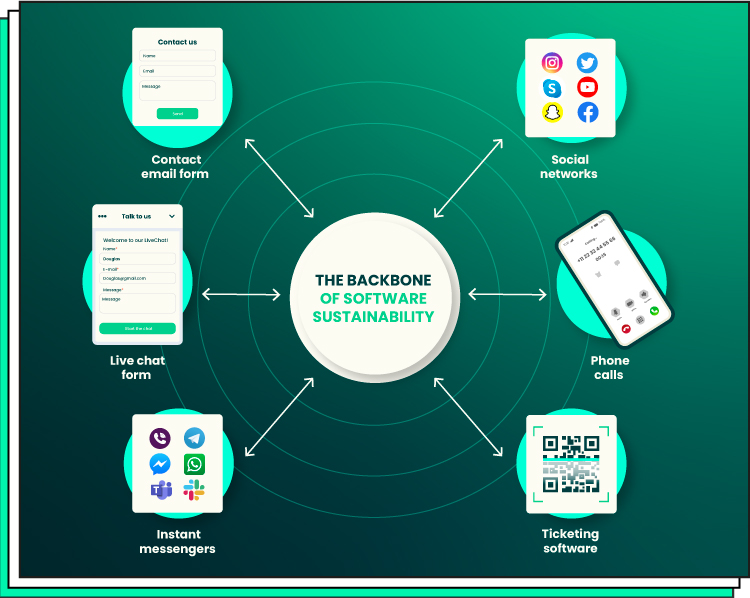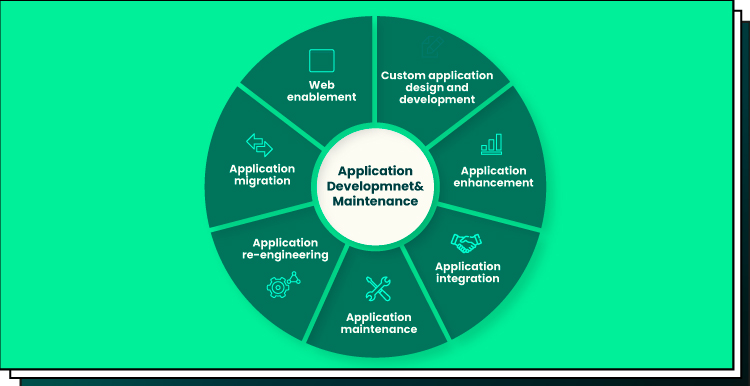Software applications have become integral to both our personal and professional lives. Whether it’s the app you use to manage your finances, connect with team members, or streamline your business operations, the performance and reliability of these applications are paramount. This is where application support and maintenance services come into play, ensuring that your software remains robust, secure, and user-friendly throughout its lifecycle.
According to Forbes, 43% of small businesses plan to invest in website performance, recognizing that ongoing technical support is critical for uptime. No surprise here: website performance directly impacts customer experience, conversions, and brand credibility. These statistics show that small businesses are starting to see technical support and maintenance not as optional, but as a strategic investment.
If you are interested in keeping your applications efficient, we recommend that you adopt our IT consulting services and get immediate advice from experienced IT engineers skilled in system maintenance. You may also consider hiring our dedicated teams for the development, testing, and support of your software to keep your project costs affordable. Before you decide, let’s learn more about the importance of technical support for your business growth.
Why Application Support Keeps Your Software Strong
Application support is a critical service encompassing both internal and external users, ensuring seamless digital operations. It falls into two main categories: technical and human support. Technical support maintains digital assets like web and mobile apps, websites, and software, addressing issues and enhancing user experience. Human support, often underestimated, aids end-users in understanding and navigating the software, reducing frustration and preventing user abandonment. Both aspects are vital for sustaining a thriving digital ecosystem and retaining users.
Consider the following application support channels, each tailored to meet various customer needs. A comprehensive technical support model should cater to a diverse range of preferences:
- Contact email form. An ideal option for users seeking to submit app support requests or inquire about specific application details. It offers a structured and convenient way to communicate with the application support service team. It offers a structured and convenient way to communicate with the application support service team and receive timely technical support.
- Live chat. When immediate responses are essential, a live chat feature proves highly effective. It addresses issues swiftly and is particularly valuable for time-sensitive inquiries, making it a vital part of comprehensive application support.
- Instant messengers. Many customers prefer instant messengers as a convenient means to reach the application support help desk. These platforms offer real-time communication for quick problem resolution. These platforms offer real-time communication for quick problem resolution and often require support staff to have strong technical skills to troubleshoot effectively on the spot.
- Social networks. Leveraging social networks provides users with rapid access to support services. It serves as a convenient channel for reaching out and receiving timely assistance, making it an important part of modern application support strategies.
- Ticketing software. For structured support management, ticketing software, such as Jira or Backlog, serves as a top-tier support channel. It centralizes support requests, assigns them to appropriate teams or individuals, and facilitates transparent monitoring of the entire support process. This approach enhances application support by ensuring every issue is tracked, prioritized, and resolved efficiently.
No matter which support channels you choose, the goal is the same: to make sure users get help when they need it quickly, easily, and with minimal friction. Whether it’s a technical glitch or a usability question, your application support strategy should cover all the bases. The more accessible and responsive your support system is, the more confident your users will feel.
Let’s work together to build a support experience your users can count on. Contact us today to get started.
Keep Apps Alive with Smart Support & Maintenance
An integral aspect of the application support and maintenance stage revolves around determining the system’s eventual retirement. Teams must make prudent decisions regarding when to conclude work on the current version, facilitating a seamless transition to a newer iteration of a product or contemplating migration to an entirely different solution. This process requires not only strategic planning but also strong technical skills to assess system dependencies, data integrity, and compatibility with future platforms.
A profound approach to the application support stage ensures the longevity, reliability, and relevance of the software application, serving as the bridge between its deployment and eventual retirement. Without diligent and continuous support, an application risks becoming obsolete, stagnant, or vulnerable to issues that could otherwise be proactively addressed. Ongoing support is the insurance policy that protects your software investment, upholding its performance, security, and user satisfaction over time. The main functionalities of this stage include:
- Continuously monitoring application performance
- Addressing any remaining issues and app bugs
- Strategically planning and prioritizing updates for improvement
- Deciding when to retire the current version and plan for the future
To carry out these functions effectively, strong technical skills are essential, from diagnosing system issues to implementing updates without disrupting performance. An experienced application support analyst plays a key role in managing these tasks, ensuring issues are identified and resolved promptly. With the right application support strategy in place, businesses can ensure their software evolves alongside user needs and market demands. It’s not just about fixing what’s broken; it’s about actively shaping a product that stays valuable, secure, and competitive over time.
Why Timely Application Support Matters
Timely application support is more than just fixing bugs; it’s about creating a seamless experience that keeps users happy, secure, and engaged. Whether you’re maintaining a SaaS product or a custom mobile app, having a responsive support system in place makes all the difference. Here’s how timely tech support helps your software succeed:
- Reduced downtime = happier users: When users hit a glitch, they want a quick fix, not a long wait. Timely support helps reduce downtime by resolving issues fast, so users can get back to work (or play) without interruption. For custom mobile development, this ensures your app stays accessible and functional on users’ preferred devices, boosting both productivity and satisfaction. Effective application support plays a key role in maintaining this reliability by providing swift resolutions and ongoing performance monitoring.
- Better security with ongoing support: Cyber threats evolve constantly. Timely application support includes regular security updates and software maintenance, helping your app stay one step ahead. Prompt patching protects sensitive data, reduces the risk of breaches, and builds user trust, especially important for mobile apps that handle personal or financial information.
- Higher user satisfaction and trust: When users know help is just a click away, they’re more likely to stick around. Fast, reliable support creates a positive user experience, leading to better reviews, stronger retention, and more referrals. For mobile apps, this could mean higher app store ratings and a loyal user base that grows over time. Robust application support ensures users always have access to the assistance they need, building trust and long-term engagement.
Efficient Ways to Track and Fix Bugs Fast
In the critical support and maintenance stage of software application development, a harmonious blend of professionalism and user-centricity is vital. Here’s how these five popular bug-tracking and resolution strategies come into play:
Issue tracking system
In the support and maintenance phase, implementing a dedicated issue-tracking system is paramount. This system serves as the nerve center for managing reported bugs and plays a crucial role in streamlining application support by organizing, prioritizing, and tracking issues from report to resolution. An application support specialist relies on this system and their deep systems knowledge to ensure no issue goes unresolved. Integrated with application performance management tools, this setup enables proactive monitoring, timely interventions, and continuous performance optimization.
Regular testing
Regular testing remains a crucial component of ongoing application support and maintenance. After each code change or update, thorough testing is conducted, including regression testing. This process aims to identify any new bugs introduced during the development of patches or version updates. By catching these issues early in the maintenance phase, the development and support teams can swiftly rectify them, preventing further disruption to users and maintaining a reliable software experience.
Automated testing
The use of automated testing tools is a lifesaver for support and maintenance teams. These tools are especially valuable for repetitive and critical test cases. In the maintenance phase, they help in detecting and reporting bugs faster and more efficiently. As users provide feedback and encounter issues, automated tests can be designed to validate fixes and ensure that the reported bug is genuinely resolved. This not only accelerates the bug resolution process but also boosts user confidence in the software’s reliability.
Code reviews
Code reviews continue to play a pivotal role in the application support and maintenance phase. When users report bugs, the development team conducts thorough code reviews to identify coding errors, logic flaws, or potential bugs in the affected areas. By addressing these issues early in the development process of patches or updates, the team prevents recurring problems and maintains a higher standard of software quality. This proactive approach minimizes the need for repetitive bug fixes and contributes to a more stable application.
User feedback
User feedback takes on even greater significance during the support and maintenance stage. Beyond soliciting feedback, support teams actively monitor user forums and customer support channels for bug reports. These reports serve as a direct channel for users to communicate their experiences and concerns. When users report bugs, support teams engage with them, acknowledging their input and providing transparency about the resolution process. This user-centric approach not only resolves issues but also fosters a sense of trust and collaboration between users and the development and app support teams.
Boost UX with Continuous App Improvements
In the dynamic realm of software development, user experience (UX) stands as a pivotal differentiator. Beyond addressing bugs, the support and maintenance phase offers a unique opportunity to elevate UX through iterative enhancements, including:
- Incorporating user feedback for UI fine-tuning.
- Aligning with evolving user preferences by adding new features.
- Creating bug-free software that continually evolves, resonates with users, and fosters long-term loyalty.
Compatibility and performance optimization for evolving platforms
The adaptability of software applications in an ever-evolving tech landscape is paramount. With new platforms, devices, and operating systems emerging continuously, support and maintenance teams ensure:
- Seamless functionality across diverse environments.
- Optimal performance, irrespective of the user’s chosen platform.
- Wider user reach and consistent, peak-level performance.
Data backup, disaster recovery, and risk mitigation
In the sphere of support and maintenance, safeguarding data and risk mitigation takes center stage. Vital measures include:
- Regular data backup and meticulously planned disaster recovery strategies.
- Swift recovery protocols in the face of hardware failures or cyberattacks.
- Minimized downtime and data loss, bolstering the application’s overall resilience.
Compliance with industry regulations and standards
Remaining compliant with evolving industry regulations is a non-negotiable aspect of the application support and maintenance service phase. As technology progresses, so do regulatory requirements. Organizations ensure:
- Vigilant monitoring of shifts in industry standards.
- Implementation of necessary compliance updates and measures.
- A secure and reputable software solution, maintaining user trust and regulatory compliance alike.
Success Stories from Real Businesses
Let’s delve into specific scenarios where the profound impact of timely application support becomes abundantly clear:
Retail excellence: In the world of e-commerce, timely support serves as the backbone of a seamless shopping experience. For retail companies operating online, it’s the lifeline that swiftly resolves any website issues. This ensures that customers can continue their shopping journey without interruption, preserving their satisfaction and loyalty.
Shopify, a leading e-commerce platform, uses AI-powered support tools and real-time monitoring to ensure merchants experience minimal downtime. During Black Friday, Shopify handled peak traffic of over 4.6 million requests per minute without major disruptions, thanks to proactive support and automated incident response systems. This level of responsiveness preserved merchant trust and customer satisfaction during critical sales periods.
Streamlined development: Timely support is the driving force behind efficient software development. It empowers customers with quick and efficient assistance when navigating through bugs or technical challenges. This proactive approach minimizes customer frustration and elevates the overall customer experience, setting the stage for long-term relationships.
Atlassian, the maker of Jira and Confluence, integrates support directly into its development lifecycle. Through its “Support Engineering” model, developers receive real-time alerts and contextual help when issues arise in production. This has reduced bug resolution time by over 40%, enabling faster release cycles and improving user experience across its SaaS products
In essence, timely support transcends being a mere option; it is an indispensable necessity for the success of any software product or service. It minimizes downtime, fortifies security, and nurtures user satisfaction, ultimately laying the foundation for sustained success. It’s not just a feature; it’s a commitment to excellence.
Smart Ways to Get Cost-Effective Application Support
To ensure cost-effective application support with a positive ROI, follow these essential steps:
Step 1. Assess needs and choose a model
Begin by thoroughly evaluating your application’s support requirements. Understanding the specific technical issues and user demands allows you and your application support analysts to tailor your application support strategy effectively. Next, select an application support model that fits your organizational needs. Whether it’s in-house tech support, outsourced services, or a hybrid approach, aligning the model with your business goals is critical for success in application support jobs.
Step 2. Optimize resources and prioritize issues
Balance the use of automation tools and human expertise to enhance application support efficiency. Modern management software can streamline workflows, enabling support teams and applications support analysts to handle application and system issues more effectively while leveraging their technical and application support skills. Focus on resolving critical technical issues and high-impact problems first. Efficient prioritization in tech support reduces downtime and improves user support.
Step 3. Enable self-help and monitor proactively
Provide user-friendly self-service tools and resources. Empowering users with access to FAQs, tutorials, and troubleshooting guides decreases the volume of tech support requests and promotes proactive user support. Invest in monitoring and issue detection tools that anticipate application support needs before problems escalate. Skilled applications support analysts use these tools to identify and address issues early, minimizing disruption and keeping systems running smoothly.
Step 4. Manage knowledge and continuous improvement
Maintain a well-organized, up-to-date knowledge base. A centralized repository enhances the ability of application support teams and application support analysts to quickly resolve recurring problems by leveraging accumulated expertise and best practices. Regularly evaluate and enhance your application support processes, encouraging skill development to boost application support skills and keep pace with evolving technologies and user expectations. Collect and analyze feedback from end-users to identify gaps in tech support and application support. Use this data to refine strategies and improve overall service quality.
Step 5. Vendor selection, measure ROI, and optimize continuously
Carefully choose cost-effective partners and third-party vendors who demonstrate strong management software ability and reliable tech support services, ensuring seamless integration with your existing application support infrastructure. Consistently assess the impact of application support on key performance metrics such as issue resolution time, user satisfaction, and operational costs. Accurate ROI measurement helps justify investments in application support jobs and technology.
Skilled applications support analysts play a vital role in monitoring these metrics and identifying areas for improvement. Adjust your application support strategy based on ROI analysis and emerging trends in tech support and technological solutions. Continuous optimization ensures your team remains responsive to technical issues and delivers outstanding user support.
By implementing these steps with a focus on strong application support, organizations can maximize efficiency, reduce costs, provide superior support experiences, meet modern user expectations, and ensure business growth.
What’s Next: Emerging Trends in Application Support
- Automation: Intelligent automation is transforming tech support by streamlining routine tasks and accelerating issue resolution. Through the automation of repetitive processes, support teams can minimize manual intervention, reduce human error, and significantly improve efficiency. By adopting advanced technological solutions to automate tasks such as log analysis, software updates, and user provisioning, organizations can ensure that their applications run smoothly with minimal downtime, ultimately enhancing user satisfaction.
- AI-driven insights: Artificial intelligence (AI) plays a pivotal role in the evolution of application support. AI-driven analytics tools are now employed to process vast amounts of data, offering invaluable insights into user behavior and application performance. By analyzing user interactions and system data, AI models can identify patterns, anomalies, and potential bottlenecks. This data-driven approach empowers application support teams to proactively address issues, optimize user experiences, and fine-tune application performance, ultimately resulting in a more responsive and user-centric support environment.
- DevOps integration: The integration of DevOps practices into application support workflows represents a significant trend in modern software development. DevOps emphasizes collaboration between development and operations teams, and its principles are increasingly applied to application support processes. This integration enables a seamless and continuous feedback loop between development and support, fostering faster issue resolution, efficient bug tracking, and the rapid deployment of fixes and updates. By breaking down silos and promoting cross-functional teamwork, organizations can enhance the overall agility and reliability of their applications while delivering timely application support to end-users.
Trust Your Application Support Needs to Forbytes
Application support isn’t just a nice-to-have; it’s the engine behind a smooth, reliable, and scalable product, especially when it comes to business-critical applications. When your app is out in the world, things don’t stop at launch. Bugs show up, users give feedback, systems update, and performance expectations grow. That’s where technical support makes all the difference.
It helps you catch issues before they become problems. It keeps your app secure, updated, and aligned with your business goals and operational processes. And most importantly, it creates a better experience for your users, so they stick around longer and trust your product more.
At Forbytes, we understand that every business is different. Maybe you’re growing fast and need to scale your app without breaking things. Or maybe your team is stretched thin and you just need someone to take the pressure off your in-house developers. We offer flexible support and maintenance services tailored to where you are now and where you want to go next.
Reach out to Forbytes today and let’s talk about what application support could look like for your business.

Our Engineers
Can Help
Are you ready to discover all benefits of running a business in the digital era?

Our Engineers
Can Help
Are you ready to discover all benefits of running a business in the digital era?












